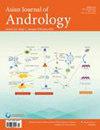Cell fate determination and lineage plasticity in prostate cancer.
IF 3
2区 医学
Q2 ANDROLOGY
引用次数: 0
Abstract
P cancer (PCa) initiation, progression, and therapy resistance involve genetic and epigenetic alterations that l e ad to ab err ant cel l l ine age specification and plasticity.1–3 The vast majority of primary prostate cancers are pathologically defined as luminal cancer with luminal cell expansion and absence of basal cells. The basal or neuroendocrine PCa is extremely rare in primary or untreated PCa. Adeno-to-neuroendocrine PCa lineage plasticity has been identified in advanced PCa following the targeted therapy of AR inhibition.2 However, the underlying mechanisms of PCa cell fate determination and lineage plasticity are still poorly understood. Therefore, systematically defining the genetic, epigenetic, and microenvironment factors in PCa cell lineage determination and plasticity may reveal the underlying molecular mechanisms and stimulate the development of novel therapeutic strategies to prevent or reverse the current therapy resistance of prostate cancers. This special issue, “Prostate Cell Fate and Diseases”, contains six original articles and five reviews to introduce some recent PCa research progress in the field of prostate cell fate determination and lineage plasticity. PCa is one of the most common cancers in men in the world. The normal prostate epithelium consists of luminal cells, basal cells, INVITED EDITORIAL前列腺癌细胞命运决定和谱系可塑性。
本文章由计算机程序翻译,如有差异,请以英文原文为准。
求助全文
约1分钟内获得全文
求助全文
来源期刊

Asian Journal of Andrology
医学-泌尿学与肾脏学
CiteScore
4.90
自引率
3.40%
发文量
2252
审稿时长
2.2 months
期刊介绍:
Fields of particular interest to the journal include, but are not limited to:
-Sperm biology: cellular and molecular mechanisms-
Male reproductive system: structure and function-
Hormonal regulation of male reproduction-
Male infertility: etiology, pathogenesis, diagnosis, treatment and prevention-
Semen analysis & sperm functional assays-
Sperm selection & quality and ART outcomes-
Male sexual dysfunction-
Male puberty development-
Male ageing-
Prostate diseases-
Operational andrology-
HIV & male reproductive tract infection-
Male contraception-
Environmental, lifestyle, genetic factors and male health-
Male reproductive toxicology-
Male sexual and reproductive health.
 求助内容:
求助内容: 应助结果提醒方式:
应助结果提醒方式:


